 |
| http://images.moviepostershop.com/one-missed-call-movie-poster-2008-1010403639.jpg |
This is the second of four Japanese horror film remakes/interpretations. As mentioned in my previous post that I have already reviewed and researched four critically acclaimed Japanese directed horror films; Ringu (1998), Chakushin Ari (a.k.a One Missed Call) (2003), Ju-on The Grudge (2002) and Dark Water (2002),
all of which have remakes/interpretations, therefore, I have decided to
watch and review these remakes/interpretations and draw
comparison-based results, highlighting (if any) identified Japanese
horror characteristics. In order to thoroughly research this
interpretation/remake I will first be summarising the plot, noting
relevant differences (if any), after that I will be looking for any
characteristics I have previously identified in my honours project thus
far, then I will discover whether this remake/interpretation is higher
in critical acclaim than the original and finally, I will be drawing
conclusive results based on my findings.
Plot Summary:
 |
| http://pegasusnews.com/media/img/photos/2008/01/05/thumbs/one_missed_call_02.jpg.728x520_q85.jpg |
- Predictability - Japanese directed horror is rather unpredictable, however, almost every death in this film (despite the plot) was predictable, be it the audio or the camera perspectives, there was not a single character death I could not point out in advance.
- Stale - the acting in this remake/interpretation was worse than that of the 2003 original. Performances seemed forced, the actors did nothing but demote the horror atmosphere and make the film just drag on until the credits finally appeared on the screen.
- CGI - visual effects were used constantly in this remake/interpretation for things such as explosions, supernatural beings/characters, glass smashing, fire, vehicles and insects. It made the entire piece look somewhat cheap and lazy.
- Introduction - the opening sequence to this remake/interpretation was one of its greatest let downs because it was sudden, unexplained and unnecessary. It may have been explained later in this version (much later), however, it evoked feelings of frustrations because it was far too early in the film to have the audience asking questions already, thus, ruining the visual experience to a certain degree.
Japanese Characteristics:
 |
| http://cps-static.rovicorp.com/2/Open/Warner%20Brothers%20Distribution/Movies/One%20Missed%20Call/_derived_jpg_q90_600x800_m0/OneMissedCall-Still5.jpg?partner=allmovie_soap |
- Setting - This version of Miike's 2003 original struggles to follow the preferred setting preferences of Japanese directed horror because this film is set both indoors and outdoors, barely projecting an isolated atmosphere because there are lots of people around most of time.
- Colour - this remake/interpretation fell short on colour depiction because the majority of colours used were high value in comparison to the low value colour patterns of Japanese directed horror. Saturation was also barely evident in this remake/interpretation, failing to capture the heightened grey-scale of Japanese directed horror.
- Lighting - Deep shadows and three point lighting are the favoured lighting techniques of Japanese directed horror, however, in this remake/interpretation, neither of these were present. In this version of the 2003 original, the central lighting choice was high key lighting, almost every section of the film was well lit, even the abandoned and burned down hospital somehow managed to still generate power.
- Composition - The depth of field in this film/remake changed constantly in this film, therefore, failing to adhere to the characteristics of Japanese directed horror which favours an infinite depth of field. Despite the flaws of this remake/interpretation, the Scaling in this film is realistic, lines are both angular and straight. The camera-work in this interpretation/remake failed to follow the characteristics of Japanese directed horror because the camera was rarely set at at higher or lower height and the side angle was barely used either. Shapes in this film are non-conflicting and do not draw or steal any focus from the performance at hand, therefore, successfully following the characteristics of Japanese directed horror.
 |
| http://i2.listal.com/image/4208254/600full-one-missed-call-screenshot.jpg |
Lisa Schwarzbaum (2008) of Entertainment Weekly also highlights the lack of success in this remake/interpretation, "you've got to deliver a lot more than a customized ringtone to impress the iPhone generation, or to scare anyone familiar with the old glimpsed-human-who-morphs-into-ghoul routine — a demand that defeats French director Eric Valette. (This is his first American production.) Shannyn Sossamon plays the Pretty Girl Who Survives with a minimum of particularity; Ed Burns offers even less as the Cop Who Believes Her. As the cop who doesn't, the comic Margaret Cho shows up for a line or two — and her on-set experience should make for another good monologue someday, considering the riffs she's done about answering-machine messages from her own very unghostly mother." (Schwarzbaum, 2008)
Neil Bastian (2008) of the BBC sheds some light on this unsuccessful title as well, "at least the reason for the haunting is one the script hadn't necessarily led you to expect, and the ghostly effects are well done. But the blurry, sped-up, head-shaking hallucination-style apparition which startled us two decades ago in Jacob's Ladder and Twin Peaks is starting to look like a cliche now, as is the arrival of spectral children accompanied by twinkly mechanical toy music. Those coming to One Missed Call in search of ground-breaking horror have definitely dialed the wrong number." (Bastian, 2008)
 |
| http://www.awn.com/files/imagepicker/1/peszko05_OneMissedCall-baby.jpg |
This film was in all honesty, a complete flop. It struggled from beginning to end to follow the narrative from the 2003 original, altering several major plot points, meeting little or none of the characteristics of Japanese directed horror and failing to achieve positive critical acclaim. The 2003 original was not met with world-class feedback and personally, I didn't think the world of it myself, however, this interpretation/remake was embarrassing and has got to be the worst film remake I have seen to date.
References:
http://www.timeout.com/us/film/one-missed-call
http://www.ew.com/ew/article/0,,20170207,00.html
http://www.bbc.co.uk/films/2008/03/31/one_missed_call_2008_review.shtml
http://www.timeout.com/us/film/one-missed-call
http://www.ew.com/ew/article/0,,20170207,00.html
http://www.bbc.co.uk/films/2008/03/31/one_missed_call_2008_review.shtml
No comments:
Post a Comment